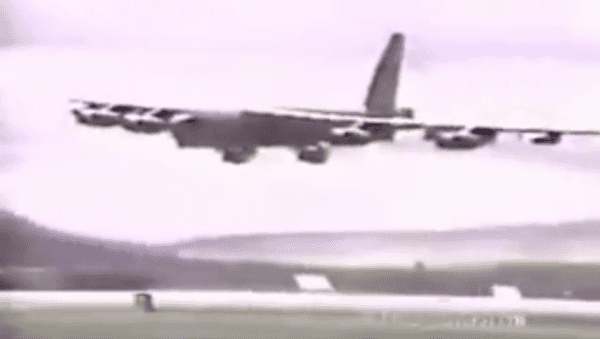On June 24, 1994, a United States Air Force B-52 crashed at Fairchild Air Force Base in Washington. The pilot, Lt. Col. Arthur Holland, pushed the behemoth aircraft beyond its limits.
The resulting crash took Holland’s life and three other officers onboard the aircraft. Holland’s erratic flight and ensuing crash was caught on film, and the event remains one of the most controversial military aircraft disasters.

A United States Air Force (USAF) Boeing B-52 Stratofortress crashes at Fairchild Air Force Base, Washington on June 24, 1994. (ATFSCrash/YouTube)
Upon investigation, one of the contributing factors of the crash was revealed to be Holland’s behavior, History Link stated. Having been described as a macho daredevil, USAF personnel testified that Holland was an aggressive pilot who often broke flight-safety rules. During previous flights, Holland flew below minimum-clearance altitude and exceeded bank-angle limitations and climbing rates.
During the B-52 flight, Holland performed a series of 60° bank turns and a 68° pitch climb, ignoring orders from his wing commander. He was also attempting a maneuver he had never performed before, a 360° turn around Fairchild’s control tower.
The video below shows various practice maneuvers performed before its final flight. The moments before the crash begin at 9:21 in the video below:
While Holland was primarily in charge of the aircraft, three other aircrew members were onboard the flight and were also found responsible for the crash. Each of the crewmen had limited flying time in the months leading up to the crash.
Furthermore, the investigation into the crash revealed that none of the men noticed that the aircraft stalled just before impact. The crew failed to apply standard recovery techniques to the aircraft as it entered the stall. However, even if proper techniques had been used, it likely would not have saved the aircraft as it was already flying too low to be recovered.

A United States Air Force (USAF) Boeing B-52 Stratofortress crashes at Fairchild Air Force Base, Washington on June 24, 1994. (ATFSCrash/YouTube)
The investigation of the accident concluded that three factors — Holland’s risky behavior, his superiors’ lack of action to his previous incidents, and the inexperienced flight crew — all contributed to the devastating crash.
Col. William E. Pellerin, Holland’s new deputy commander for operations before the crash, was the only Air Force officer to be reprimanded for his inaction in curtailing Holland’s behavior.

A United States Air Force (USAF) Boeing B-52 Stratofortress crashes at Fairchild Air Force Base, Washington on June 24, 1994. (ATFSCrash/YouTube)
Today, the B-52 crash footage is used as a training tool for both civilian and military pilots. It serves not only as a reminder to follow strict safety regulations, but also as a case study for Air Force leaders in appropriately managing their officers.



